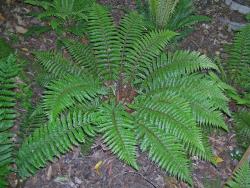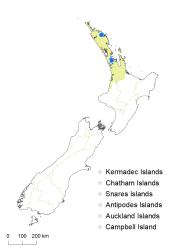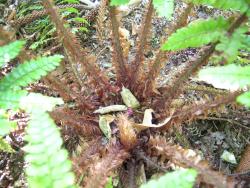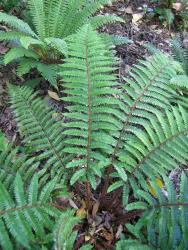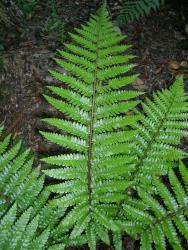- ≡ Aspidium polyblepharum Roem. ex Kunze, Bot. Zeitung (Berlin) 6: 672 (1848) – as Aspidium polyblepharon
Polystichum polyblepharum has an erect rhizome, dense greyish-brown scales that are ovate and irregularly toothed on the margins, and fronds up to c. 600 mm long that lack bulbils. The laminae are 2-pinnate and dark, glossy green. The secondary pinnae have a basal acroscopic lobe, and are sharply toothed on the margins and apices, ending in extended hair-points. The abaxial surfaces are abundantly covered in long hair-like scales with toothed margins. The indusia are concolorous, flat and situated closer to the margin than to the costa.
North Island: Northland, Auckland.
Altitudinal range: 10–110 m.
Polystichum polyblepharum has been recorded from Kerikeri and Auckland city, and is seemingly quite common around Hamilton based on iNaturalist obervations. It occurs naturally in eastern China, Korea and Japan (Zhang & Barrington 2013).
Wild plants of Polystichum polyblepharum are mostly found in cultivated areas or garden centres, occurring as self-sown plants in pots, on ponga logs, on basalt rock faces or on clay banks.
Heenan et al. (2004). Voucher AK 221536, 1994.
Polystichum polyblepharum is often sold in New Zealand erroneously under the name P. braunii (Spenn.) Fée, which is a different species from the northern hemisphere.



